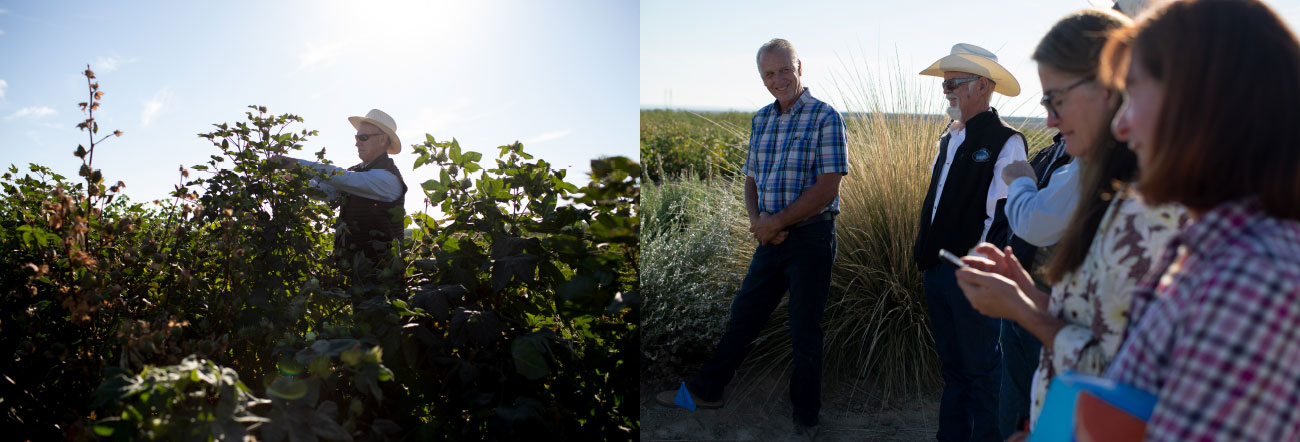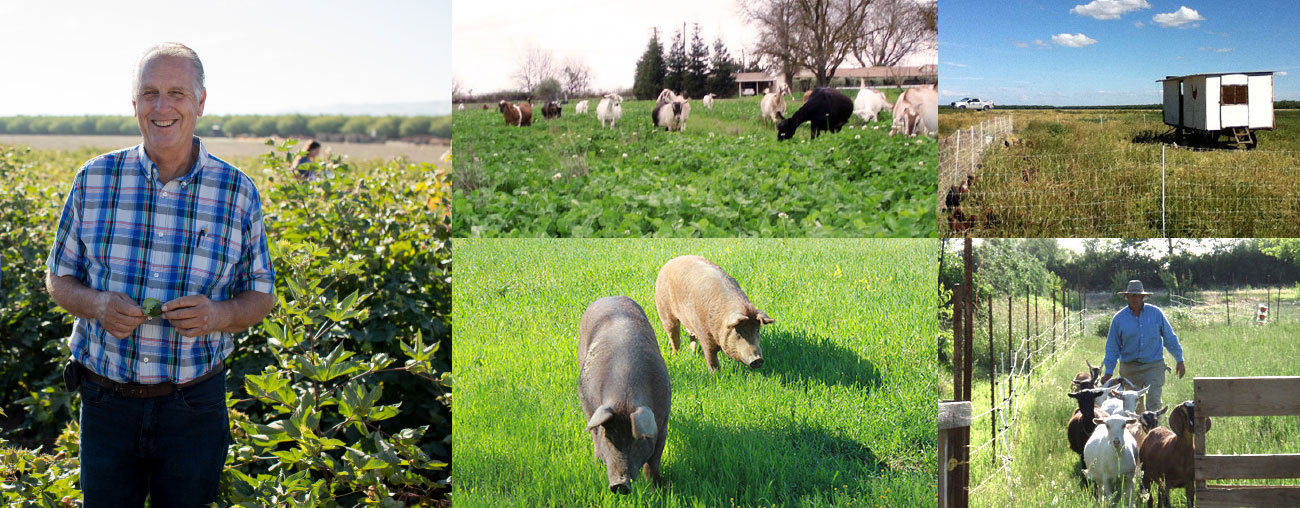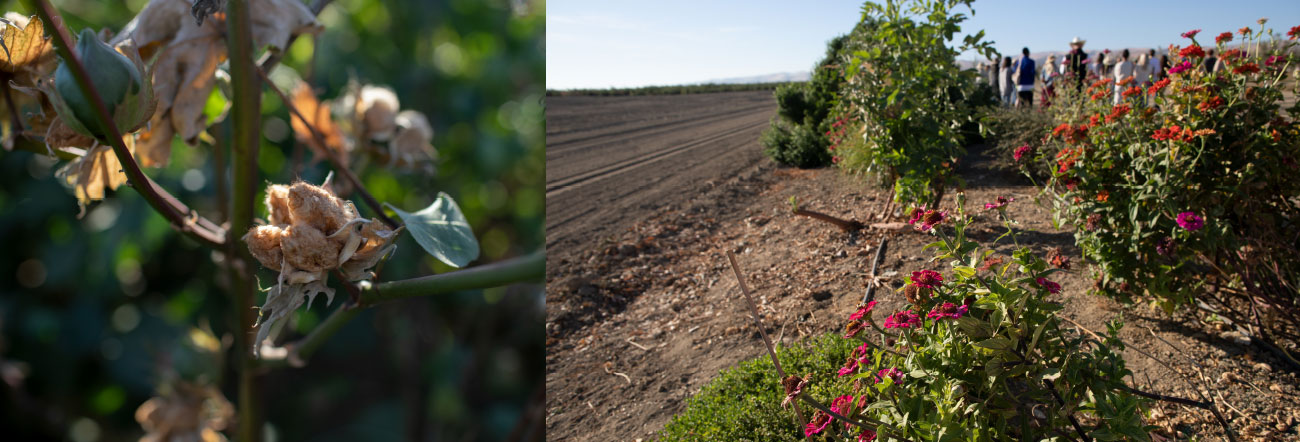Cotton is part of the broader California agricultural system wherein shifting practices opens pathways for whole systems regeneration. For the past year, and throughout a planting cycle, Fibershed has been visiting cotton growers throughout Northern and Central California in an effort to understand the system as it is. This is an examination formed through proximity and a commitment sealed through mutuality: we share the responsibility from soil to skin to deconstruct the narratives around this favored fiber and dig deep into what it could look like to restore the soil undergirding this system. This series on cotton explores the stories of several innovators and creative minds, examining cotton as it is in our home community to understand our collective opportunity to shift practices from soil to soil.
Photographed by Paige Green

Cotton encouraged John Teixeira to consider organic farming, back in the late 1980s.
“It was the only thing I knew, transitioning from cotton that was conventional to organic. But I couldn’t find anyone that wanted to buy that cotton,” he says looking back. “They didn’t even know how to deal with it. It was a hard learning experience.”
But fast forward two decades and Teixeira who owns and operates Lone Willow Ranch, a 90-acre property that is Demeter-certified biodynamic, is taking his understanding of regenerative agriculture further by working to cycle all the necessary nutrients from within the boundaries of the farm, and forgoing foreign inputs.
Teixeira’s home ranch is situated on the banks of the San Joaquin River in the small rural community of Firebaugh, California. He works both at this location and also contributes to the decision making and practice implementation on his larger scale family farm known as Teixeira & Sons LLC. Teixeira & Sons has been one of the key stakeholder farms within the Sustainable Cotton Project: the farm grows as much as 2800 acres of cotton and they have continued to encourage and implement ecologically thoughtful practices throughout their tenure in the region.
The Sustainable Cotton Project began in 1996 and has concentrated on creating a high-quality cotton fiber in the US that’s free of the most toxic pesticides and herbicides. Though not certified organic, it’s eliminated the most dangerous chemicals, and helped farmers connect with manufacturers under the Cleaner Cotton™ branding.
Teixiera’s understanding of sustainable agriculture has evolved over the years; more recently it’s culminated into a passion for biodynamic, because it encourages a farm to be self-sufficient.
“I don’t have to buy nitrogen, I just grew it. And that’s the key to organics of the future,” he says. “That’s also money in the bank.”
His farming philosophy at Lone Willow Ranch, which he refers to as his ‘oasis,’ is to use what’s already on the ranch, not add to it. His goal is to be 100 percent self-sufficient — no external inputs.
After having grown tomatoes, grains, cotton, and a variety of other cash crops, Teixeira added animals and livestock to the mix. His first investment was in goats. Then he added pigs. Then a few cows. But they all come with a purpose, he says. “The animals can do some of the farming, and take that workload off us, the farmers.”

He’s referring to their grazing: as these animals eat through some of the grains and cover crops that grow on the farm, they allow for “natural” tillage. This helps keep carbon in the soil, producing a more nutrient-dense soil for him to grow cash crops the next season. The animals also produce manure, which only adds to the soil’s richness.
By having his livestock feed off of what’s grown right there on the farm, he’s not spending a lot of money buying for them. Plus, he puts them to work, by eating their way through his fields, leaving him with soil that retains water better.
In California, a state that’s endured drought for years, this helps Teixeira keep his costs low, and less dependent on irrigation or even rainfall. “[The soil] is my sponge,” he says.
At the 90 acres of Lone Willow Ranch, he plans on expanding hedgerows and field borders — there is already one 1100 ft. hedgerow, and a new hedgerow will be added this year through California’s Healthy Soils Program funding. Here, he wants to increase the biodiversity of the ranch as a whole, in a region, he says, “where much of the native habitat has been removed and replaced with large agricultural operations.”
Planting trees and shrubs protects the soil, builds soil health, increases wildlife habitat, and that in turn, brings in beneficial insects, raptors, songbirds, and pollinators — all while increasing biological activity in the soil. Putting vegetation in hedgerows also helps to buffer extreme weather events, stores carbon, and makes the farm more resilient as a unit.
“Evaluating and measuring success is an ongoing activity, as I walk the hedgerows,” he explains. “I observe how they are becoming established and growing, ensuring they are properly irrigated, and replanting where necessary. Seeing the plants grow, observing the wildlife that comes to the hedgerows, watching the leaves develop and then turn color and fall to replenish the soil all are ways I measure and evaluate and appreciate the biological diversity that the hedgerows bring to my farm.”

Lone Willow Ranch is an ideal reflection of Teixeira as a farmer and his vision for the future of agriculture in the Valley. Alongside the ranch, he works with his brothers to manage a larger property, Teixeira & Sons LLC. where his family has grown cotton since the 1950s.
Tucked within the expansive acres managed by Teixeira & Sons LLC is Turner Island Ranch in Merced, California. Here, Teixiera and his brothers are applying compost to 78 acres of annual cropland. They’re using farm-made compost, and applying it at 6 tons per acre for 3 years.
The hope is that it will positively affect crop yields and quality through soil building, with a primary goal being to increase the soil organic matter over 2 percent. Compost applications will enhance the beneficial bacteria and fungi in the soil that break down organic matter into humus, a rich, dark soil filled with decomposed matter.
Improving soil biology and increasing organic matter levels in the soil lead to benefits of improved water holding capacity, reduced run-off, improved nutrient availability, and improved soil tilth. To monitor the nutrient density, soil samples will be taken before the project start, and annually through the project duration. Success will be measured looking at the soil organic matter levels, NPK on soil tests, as well as evaluating irrigation costs and the amount of fertilizer needed.
Growing organically when it comes to cotton is not easy, he acknowledges. “One of the hardest elements of organic cotton production is managing the impacts of the lygus pest. It likes to spend time in the wet areas, grasslands, and the foothills and then ventures into cotton.”
But still pesticides are a very last resort. Instead, he turns to the rhythms of nature to address pest issues. For instance, Teixiera also grows alfalfa, which hosts the lygus pest. So he leaves the alfalfa to dry, after being harvested on the fields to dry. The result? The lygus tends to stay away from the cotton.
As the cost of farming increases steadily, Teixiera argues that these regenerative practices can be cost-effective as well as being more in tune with nature. “Environmental concerns are very prevalent now. There is a movement of instead of being a hard line, people are willing to take or try something different. The biodynamic movement, for instance, is really happening and being led by young people.”





